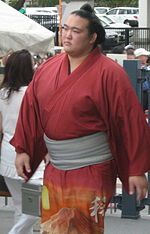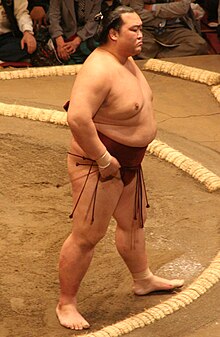Kisenosato Yutaka

|
|
| Personal data | |
|---|---|
| real name | Yutaka Hagiwara |
| Born | 3rd July 1986 |
| place of birth | Ibaraki, Japan |
| size | 1.87 m |
| Weight | 175 kg |
| Career | |
| Heya | Tagonoura |
| Career record | 800–496–97 714–453–97 (makuuchi) |
| debut | March 2002 |
| Highest rank | Yokozuna (January 2017) |
| Tournament victories | 2 (Makuuchi) 1 (Makushita) |
| resignation | January 2019 |
Kisenosato Yutaka ( Japanese 稀 勢 の 里 寛 ; * July 3, 1986 in Ibaraki as Yutaka Hagiwara ( 萩 原 寛 )) is a former Japanese sumo wrestler . From 2004 to 2019 he fought in the Makuuchi Division, the highest Japanese league. In January 2017, he was promoted to 72nd yokozuna , the highest rank in sumo. On January 16, 2019, he resigned as a yokozuna and thus ended his active career.
Career
Lower Leagues
Hagiwara was recruited by the former yokozuna Takanosato in 2001 and joined the Naruto-beya stable (which was renamed Tagonoura-beya in 2013). In May 2002 Hagiwara made his debut in professional sumo, initially fighting under his family name.
After he was able to complete his first two tournaments with a 6-1 record, he was allowed to fight in the fourth highest division ( Sandanme ) in the same year . In his fifth tournament in the Sandanme Division he managed a perfect 7-0 record. In the playoff for the tournament victory, however, he was subject to the experienced Tenpozan. After the tournament, Hagiwara rose to the Makushita division. In January 2004, he won the makushita yusho. In the following tournament, thanks to his five wins, he was promoted to the Jūryō division.
During his short time in Jūryō (three tournaments) Hagiwara always achieved a positive balance ( Kachi-koshi ). Then he rose to the first-class makuuchi division. When he made his debut in November 2004, he was unusually young at the age of 18. Hagiwara received the ring name Kisenosato from his stable master.
Maegashira and Junior San'yaku
During his first five tournaments, Kisenosato was in the lower maegashira ranks. In September 2005 he drew attention to himself with a balance of 12-3, which earned him his first kantō-shō . He rose to Maegashira 5 and was allowed to compete with the strongest fighters for the first time in the following tournament.
In July 2006 he made his debut as Komusubi . In the following years he commuted several times between the San'yaku and Maegashira ranks. He captured after victories over the yokozuna Asashōryū (January 2008) and Hakuhō (September 2008) his first two Kinboshi . In March 2009, Kisenosato achieved the rank of sekiwake for the first time . In November 2010, Kisenosato won his third and final Kinboshi when he ended Hakuhō's 63-bout winning streak.
As of 2011, Kisenosato was permanently established in the San'yaku ranks. The highlight of the year was the tournament in September, which he finished with 12-3 and thus won his first Jun-Yusho. In total, he collected 32 wins in the last three tournaments of the year and was then named Ōzeki .
Ōzeki
In his new rank, Kisenosato showed consistently good performances and was often able to achieve a double-digit number of wins. In May 2013 he was still unbeaten after 13 days, but only won one Jun-Yusho, as in the three tournaments that followed. After a 13-2 in November 2013, he was considered a candidate for a yokozuna promotion, for which he should have won the next tournament. In contrast, Kisenosato suffered his first make-koshi in three years in January 2014 and was therefore Kadoban-Ōzeki for the only time in March 2014 . The only high point of 2014 was a Jun-Yusho in May, in which he was able to record 13 wins.
2015 was rather inconspicuous, with Kisenosato winning two Jun-Yusho but only winning 11 times. Instead, his career picked up speed again in 2016: It came to the unusual constellation that Kisenosato achieved the most victories (69) of all makuuchi fighters in the calendar year, but the first tournament victory was still denied him. At the end of the year there were another four Jun yusho on record.
In January 2017, Kisenosato finally won his first yusho with the Hatsu Basho. After 14 days he was already the winner. In addition, he defeated the yokozuna Hakuhō on the final day and finished the tournament with a record of 14-1. This was followed by the appointment of Kisenosato as the 72nd yokozuna.
Yokozuna
Through Kisenosato's appointment, a native Japanese was again a yokozuna for the first time since Takanohana's resignation in 2003. The last promotion of a native Japanese was in 1998 (Takanohana's brother Wakanohana ). On January 27, Kisenosato performed his first dohyo-iri (entering the ring) ceremony as a yokozuna at Meiji Shrine .
In March 2017 he won the Haru Basho. On the 13th day of the tournament he was injured, but was able to catch up with Terunofuji on day 15 by defeating Terunofuji and defeating him again in the play-off. This made Kisenosato the first yokozuna in 22 years to win the title on his debut in the highest rank. For the May tournament, Kisenosato was the first Japanese since Takanohana to be named Yokozuna 1 East after 16 years.
The following year and a half were marked by injuries for Kisenosato, which is why he prematurely ended eight tournaments in a row or did not start at all. It wasn't until September 2018 that he achieved a kachi-koshi again.
Others
Since January 2009 Kisenosato owner of Araiso-Kabu, allowing him to end his career as Oyakata to remain in Sumoverband.
style
Kisenosato wins about two-thirds of his fights by forcing the opponent out of the ring: he ends 41 percent of his fights with yorikiri (pushing out with grip on the mawashi), another 25 percent with oshidashi (pushing out without grip on the mawashi). In other fighters, on average , these two kimarite are used in less than half of all fights. Kisenosato's third most common technique is tsukiotoshi with 8 percent ( knocking down with the arm against the upper body of the opponent).
statistics
| year | Hatsu (January) | Haru (March) | Natsu (May) | Nagoya (July) | Aki (September) | Kyushu (November) | Win rate |
|---|---|---|---|---|---|---|---|
| 2002 | Maezumo | Jonokuchi 26 East 6-1 |
Jonidan 61 East 6-1 |
Sandanme 95 West 4-3 |
Sandanme 77 West 5-2 |
75% | |
| 2003 | Sandanme 49 West 5-2 |
Sandanme 21 West 3-4 |
Sandanme 37 East 7-0 D |
Makushita 25 East 3-4 |
Makushita 35 West 5-2 |
Makushita 25 East 4-3 |
64% |
| 2004 | Makushita 18 East 7-0 Y |
Makushita 1 East 5-2 |
Juryo 12 West 9-6 |
Juryo 6 East 8-7 |
Juryo 3 West 9-6 |
Maegashira 16 West 9-6 |
64% |
| 2005 | Maegashira 12 West 6-9 |
Maegashira 15 West 8-7 |
Maegashira 11 West 5-10 |
Maegashira 15 West 7-8 |
Maegashira 16 West 12-3 |
Maegashira 5 East 5-10 |
48% |
| 2006 | Maegashira 9 East 8-7 |
Maegashira 7 East 10-5 |
Maegashira 1 East 8-7 |
Komusubi 1 West 8-7 |
Komusubi 1 East 8-7 |
Komusubi 1 East 8-7 |
56% |
| 2007 | Komusubi 1 East 7-8 |
Maegashira 1 East 6-9 |
Maegashira 3 West 6-9 |
Maegashira 6 West 11-4 |
Komusubi 1 East 6-9 |
Maegashira 2 East 9-6 |
50% |
| 2008 | Maegashira 1 East 10-5 |
Komusubi 1 East 8-7 |
Komusubi 1 East 10-5 |
Komusubi 1 East 6-9 |
Maegashira 2 East 6-9 |
Maegashira 4 East 11-4 |
57% |
| 2009 | Komusubi 1 East 8-7 |
Sekiwake 1 West 5-10 |
Maegashira 4 East 13-2 |
Sekiwake 1 West 9-6 |
Sekiwake 1 East 7-8 |
Komusubi 1 East 6-9 |
53% |
| 2010 | Maegashira 3 West 9-6 |
Komusubi 1 East 9-6 |
Sekiwake 1 East 8-7 |
Sekiwake 1 East 7-8 |
Komusubi 1 East 7-8 |
Maegashira 1 East 10-5 |
56% |
| 2011 | Sekiwake 1 East 10-5 |
called off | Sekiwake 1 West 8-7 |
Sekiwake 1 West 10-5 |
Sekiwake 1 West 12-3 y |
Sekiwake 1 East 10-5 |
67% |
| 2012 | Ozeki 3 West 11-4 |
Ozeki 2 East 9-6 |
Ozeki 2 East 11-4 |
Ozeki 1 East 10-5 |
Ozeki 1 West 10-5 |
Ozeki 1 West 10-5 |
68% |
| 2013 | Ozeki 1 East 10-5 |
Ozeki 1 East 10-5 |
Ozeki 1 East 13-2 yrs |
Ozeki 1 East 11-4 yrs |
Ozeki 1 East 11-4 yrs |
Ozeki 1 East 13-2 yrs |
76% |
| 2014 | Ozeki 1 East 7-8 |
Ozeki 2 East 9-6 |
Ozeki 1 East 13-2 yrs |
Ozeki 1 East 9-6 |
Ozeki 1 West 9-6 |
Ozeki 1 West 11-4 |
64% |
| 2015 | Ozeki 1 East 11-4 yrs |
Ozeki 1 East 9-6 |
Ozeki 1 East 11-4 yrs |
Ozeki 1 East 10-5 |
Ozeki 1 West 11-4 |
Ozeki 1 West 10-5 |
69% |
| 2016 | Ozeki 1 East 9-6 |
Ozeki 1 West 13-2 y |
Ozeki 1 East 13-2 yrs |
Ozeki 1 East 12-3 yrs |
Ozeki 1 East 10-5 |
Ozeki 1 West 12-3 y |
77% |
| 2017 | Ozeki 1 East 14-1 Y |
Yokozuna 2 West 13-2 P |
Yokozuna 1 East 6-5-4 |
Yokozuna 2 East 2-4-9 |
Yokozuna 2 East 0-0-15 |
Yokozuna 2 East 4-6-5 |
68% |
J = Jun-yusho (2nd place)
Oddities
Kisenosato made his debut in the Makuuchi Division at the age of 18.
Kisenosato won the Shukun-sho five times. No other active rikishi did this more often.
On the second day of the Kyushu Basho 2010, the then maegashira Kisenosato ended the winning streak of yokozuna Hakuhō, who had previously remained unbeaten for 63 fights in a row.
Kisenosato is the only active rikishi in the makuuchi division who has participated in every tournament since March 2002. Until January 2014 he didn't miss a fight. On the last day of the Hatsu Basho 2014, he did not take part in the fight against Kotoshōgiku due to an injury , so he won by fusen .
Web links
- Info page of the Japanese Sumo Association
- Profile on Sumo Reference
Individual evidence
- ↑ Kisenosato promoted to yokozuna. (Www.cibersumo.com)
- ^ Kisenosato becomes yokozuna. (No longer available online.) In: www3.nhk.or.jp. NHK World , January 25, 2017, archived from the original on January 25, 2017 ; Retrieved January 25, 2017 . Info: The archive link was inserted automatically and has not yet been checked. Please check the original and archive link according to the instructions and then remove this notice.
- ↑ Kisenosato's first dohyo-iri at Meiji Shrine (The Japan Times)
- ↑ Kisenosato wins the Haru Basho 2017 (www.cibersumo.com)
- ↑ History of Araiso-Kabu (Sumo Reference)
- ↑ Victory techniques used according to the Sumo Reference (as of January 2018)
| personal data | |
|---|---|
| SURNAME | Kisenosato, Yutaka |
| ALTERNATIVE NAMES | 稀 勢 の 里 寛 (Japanese); Hagiwara, Yutaka (maiden name); 萩 原 寛 (Japanese, maiden name) |
| BRIEF DESCRIPTION | Japanese sumo wrestler in the makuuchi division |
| DATE OF BIRTH | 3rd July 1986 |
| PLACE OF BIRTH | Ibaraki |

